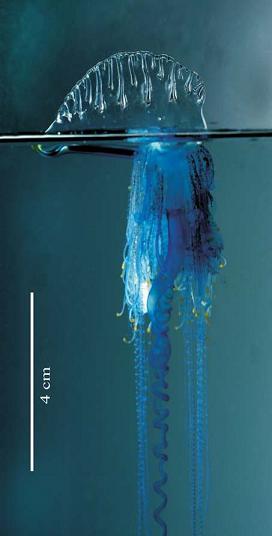Unlike the normal jellyfish, the "Portuguese warship" is not a single organism but a colony of many organisms (called polyps), each of which has a unique function. One of the polyps develops into a sail-like float that reaches up to thirty centimeters in length and up to ten centimeters in height.

"Portuguese man-of-war" (or, in its scientific name, Physalia physalis) is a distant relative of the common jellyfish on our shores. Unlike the normal jellyfish, the "Portuguese warship" is not a single organism but a colony of many organisms (called polyps), each of which has a unique function.
One of the polyps develops into a sail-like float that reaches up to thirty centimeters in length and up to ten centimeters in height. Some of the polyps develop into hunting arms that are over ten meters long and a few millimeters in diameter. The other polyps deal with digestion and reproduction. The colony feeds on plankton and small fish that are hunted by the hunting arms - contact with the arms causes immediate paralysis to most of the animals. Very little is known about the living habits of the colony. In particular, it is not clear what the role of the sail is in the life of the colony and whether there is someone who controls it. These are the two questions that were at the center of the research of professors Gil Yosilevsky and Danny Weiss from the Faculty of Aeronautics and Space Engineering at the Technion.
The researchers found that the answers to both questions are derived from the study of the hydrodynamics of the hunting arms. With no movement in the water, the hunting arm descends vertically downwards due to its negative buoyancy force. When its upper end is dragged across the surface of the water, the arm is inclined at an angle to the vertical due to the resistive force of the water. This angle increases with drag speed, but decreases with arm diameter. Because for different locomotives, drag in the water causes them to settle at different angles to the vertical. The result is that the arms spread like a fan.
Each of the arms functions as a rod, and hence it seems that the role of the sail is to spread the rods. The only problem with this arrangement is that it only works in a narrow range of towing speeds (sailing speeds) - without motion, all the booms go vertically down, while at high speed they all drag across the water. Indeed, "Portuguese warships" were observed sailing at an almost constant speed - around half a knot (about a kilometer per hour), regardless of the wind speed at the time of observation.
(Human) sailors know very well that in order to maintain a constant speed in the path, when the wind gets stronger, the sail must be released - that is, the angle between the sail and the wind must be reduced. The colony does this exactly as the Portuguese warship, after which it is named, would do - it unfurls the sail. Only, unlike the warship, where the release of the sails was carried out by many sailors according to the captain's instructions, the colony does it automatically (that is, without deliberate "thought") with the help of the dynamics of the arms.
The colony's underwater drag comes from the hunting arms and the rest of the polyps (whose function is digestion and reproduction). The position of the long arms in the colony is relatively behind and on the side of the sail where the wind hits ("upwind"), while the position of the other polyps is relatively forward and close to the axis of the sail. The long arms rise towards the surface of the water as the speed increases, while the other polyps apparently maintain their shape. The drag of an arm dragged lengthwise is significantly lower than the drag of an arm dragged across it, so when the arms rise towards the surface of the water, their relative contribution to the underwater drag is small.
Since the relative drag reduction comes from the rear (side) part of the sail, the raising of the arms "releases" the rear part of the sail and thus decreases its angle in relation to the wind; Unleashing the sail reduces its gravity and prevents an increase in sailing speed. In other words, the arms function as a natural controller that maintains the sailing speed exactly in the area where they are spread out in a large fan.
Looking at the hunter's arms and how they are attached to the sail reveals that the Portuguese warship is a skilled fisherman hauling his rods with a sail. All control over the fisherman is automatic - the sail adjusts itself in the most suitable way for the deployment of the rods.
"There is a lot to learn from the creatures in nature, in hydrodynamics and aerodynamics in particular. Their survival for hundreds of millions of years is no accident," the Technion researchers conclude.

One response
The Physalia physalis that forms a colony of polyps, like corals to whose family it belongs, but unlike common corals whose colony polyps are identical, in Physalia there is a differentiation of the polyps to create different functions in the colony. Wonderful ways of evolution! What looks like a single organism is actually a colony of organisms with specializations. This is reminiscent of stem cell differentiation in normal organisms. Is it possible that similar differentiation mechanisms operate in both cases? Perhaps by investigating the differentiation of the polyps, which are larger than cells and perhaps because of this it is easier to investigate, it will be possible to discover the secret of the differentiation of the stem cells?